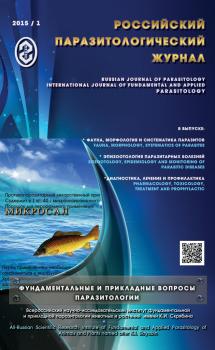Intensive development of the parasitic diseases immunology in the past decade allows making a definite conclusion about the features of the immune response formation in helminthiasis and its key problems, such as short duration, low-efficiency and the ability to cause the development of immunopathological processes. Objective of research: The aim of this review was to identify most significant stages of helminthiasis immunogenesis wich can cause its low protective ability, and for which further comprehensive study of modern molecular biologists, geneticists, biochemists, immunologists and parasitologists should be held to clarify the immunopathology induction mechanisms and improve methods of prophylaxis, diagnosis and treatment of these diseases. Results and discussion. Studies have revealed that the main condition for relationship building in the system “parasite-host” is the presence of protection mechanisms in helminths against exposure to the host’s immune system and immunomodulation mechanisms up to the complete immunosuppression in host. Products of helminths vital activity, so-called secretory-excretory products (SEPs), as well as changed in the process of pathogenesis host proteins and cells become a powerful immune stimulus and activate mechanisms for general and local immunity. The following defense mechanism in helminthiasis is the most effective: participation of IgE antibodies class and IgG2 subclass which play a major role in the activation of cell adhesive activity; influence of cytotoxic T cells (T killer cells, CD8+ -cells); involvement of macrophages, activated with T-cells; work of induced effector cells (eosinophils, neutrophils, mast cells, platelets, etc.), and the results of natural killer (NK) and regulating Treg- lymphocyte population (CD4 + CD25 + -cells) activity. It was shown that helminthiasis is accompanied by oxidative stress, which is characterized by decreased activity of catalase, superoxide dismutase, and an increase of lipid peroxidation products, which may cause primary DNA damage underlying in gene and chromosomal mutations that is shown in prior studies. Parasites metabolites have a cytotoxic effect on somatic, generative and immune cells of host, causing the increase of apoptotic cells among them. Theoretical significance of the data on identification problems of helminthiases immunology is undoubted. Its practical implementation offers the significant increase in the effectiveness of helminthiasis prevention and control.
helminthiases, immunity, evolutionary immunomodification, cytokines, immunopathology.
Целью настоящей обзорной работы было определить роль цитокинов в индукции иммунопатологии при гельминтозах для последующего усовершенствования методов профилактики, диагностики и лечения этих заболеваний.
Наиболее полному иммунологическому изучению до последнего времени подвергались гельминтозы, вызываемые тканевыми гельминтами (трихинеллез, эхинококкоз, описторхоз, филяриатозы, ларвальные тениидозы и др.). Значительно меньше имеется исследований по механизмам индукции клеточного и гуморального иммунитета, а также процессов иммунопатологии при полостных кишечных гельминтозах, в том числе с мигрирующими стадиями (аскаридозе, токсокарозе, трихоцефалёзе, энтеробиозе, анкилостомозе и др.).
Как показали наблюдения, естественная иммунизация организма хозяина при полостных гельминтозах осуществляется, в первую очередь, не за счет непосредственного контакта инвазионных стадий гельминта с клетками и тканями хозяина, а за счет секреторно-экскреторных продуктов, выделяемых ими в процессе жизнедеятельности, а также за счет антигенов, высвобождающихся из тканей паразитов в случае их гибели и распада.
1. Koyko R., Sanshayn D., Bendzhamini E. Immunology: tutorial. (Russ. ed.: Kamaev A.V., Kuznetsova A. Yu., Immunologiya: uchebnoe posobie. M., 2008, Akademiya, 368 p.). (In Russian).
2. Lazareva Yu. B., Filippova A.V., Romanova L.M., Grishina E.A. Actual problems of immunity suppression at helminthiasis. Fundamental’nye Nauki i Praktika. Sbornik Nauchnyh Trudov [Proceedings: Fundamental Sciences and Practice], 2010, vol. 2, pp. 70 - 71. (In Russian).
3. Men’shikov I.V., Beduleva L.V. Vvedenie v immunologiyu. [Introduction to Immunology], 2010, Moscow- Izhevsk, Publ. «Regular and Chaotic Dynamics», 140 p. (In Russian).
4. Ozeretskovskaya N.N. Organ pathology at the chronic stage of tissue helminthiasis: role of blood and tissue eosinophilia, immunoglobulinemia E, G4 and the immune response inducing factors. Med.Parazitologiya i Parazitarnye Bolezni. [Medical Parasitology and parasitic diseases], M., 2000, no.4, pp. 9-14 (In Russia).
5. Adewusi O.I., Nix N.A., Lu X. e.a. Schistosoma mansoni: relationship of tumor necrosis factor to morbility and collagen deposition in chronic experimental infection. Exp. Parasitol., 1996, vol. 84, pp. 115-123.
6. Dai W.J., Gottstein B. Nitric oxide-mediated immunosuppression following murine Echinococcus multilocularis infection., Immunology, 1999, vol. 97, no. 1, pp. 107-116.
7. Davies S.J., Lim K.C., Blank R.B. e.a. Involvement of TNF in limiting liver pathology and promoting parasite survival during schistosome infection., Int. J. for Parasitol., 2004, vol. 34, no. 1, pp. 27-36.
8. Estaquier J., Marguerite M., Sahuc F. e.a. Interleukin 10-mediated T cell apoptosis during the T helper type 2 cytokine response in murine Schistosoma mansoni parasite infection., Eur. Cytokine Netw, 1997, vol. 8, pp. 153-160.
9. Fallon P.G., Smith P., Dunne D.W. Type 1 type 2 cytokine producing mouse CD4+ and CD8+ cells in acute Schistosoma mansoni infection, 1998, Eur. J. Immunol., vol. 28, pp. 1408-1416.
10. Garside P., Sands W.A., Kusel J.R. е.а. Is the induction of apoptosis the mechanism of the protective effects of TNF alpha in helminth infection? Parasite Immunol., 1996, vol. 18, no. 3, pp. 111-113.
11. King C.L., Malhotra I., Mungai P. e.a. Schistosoma haematobium-induced urinary tract morbidity correlates with increased tumor necrosis factor-alpha and diminished interleukin-10 production, J. Infect. Dis., 2001, vol. 184, no. 9, pp. 1176-1182.
12. Lundy S.K., Lerman S.P., Boros D.L. Soluble egg antigen-stimulated T helper lymphocyte apoptosis and evidence for cell death mediated by FasL+ T and B cells during murine Schistosoma mansoni infection, Infection and Immunity, 2001, vol. 69, no. 1, pp. 271-280.
13. Osman M.M., Abo-El-Nazar S.Y. IL-10, IFN-gamma and TNF-alpha in acute and chronic human fascioliasis. J. Egypt. Soc. Parasitol., 1999, vol. 29, no. 1, pp. 13-20.
14. Rumbley C.A., Zekavat S.A., Sugaya H. e.a. The schistosome granulema: characterization of lymphocyte migration, activation and cytokine production. J. Immunol., 1998, vol. 161, pp. 4129-4137.





